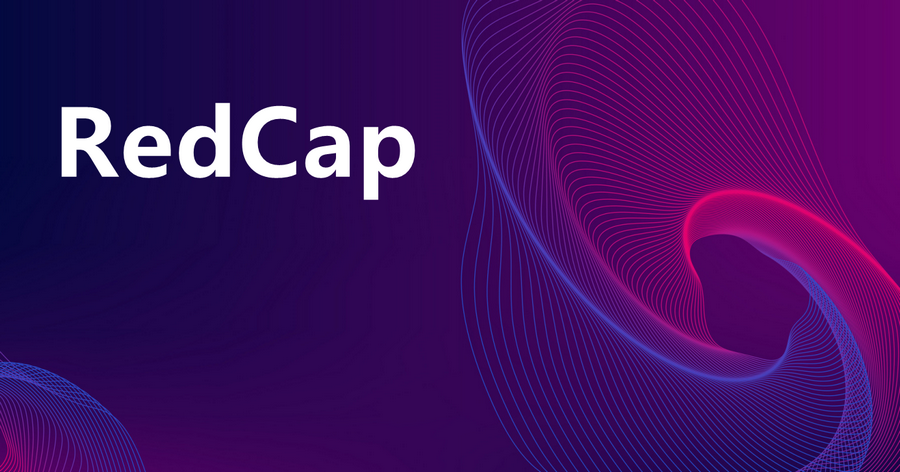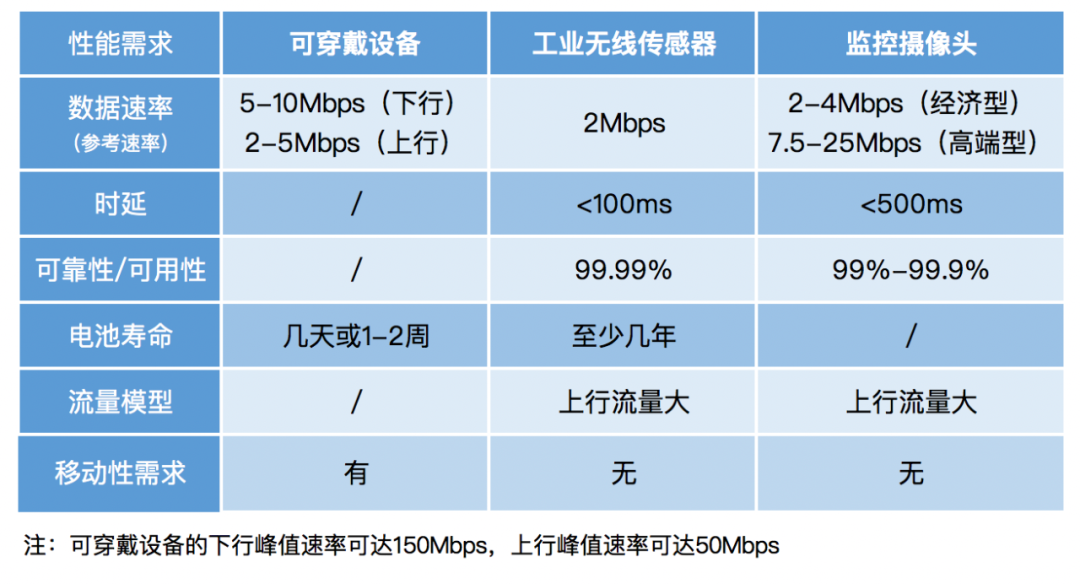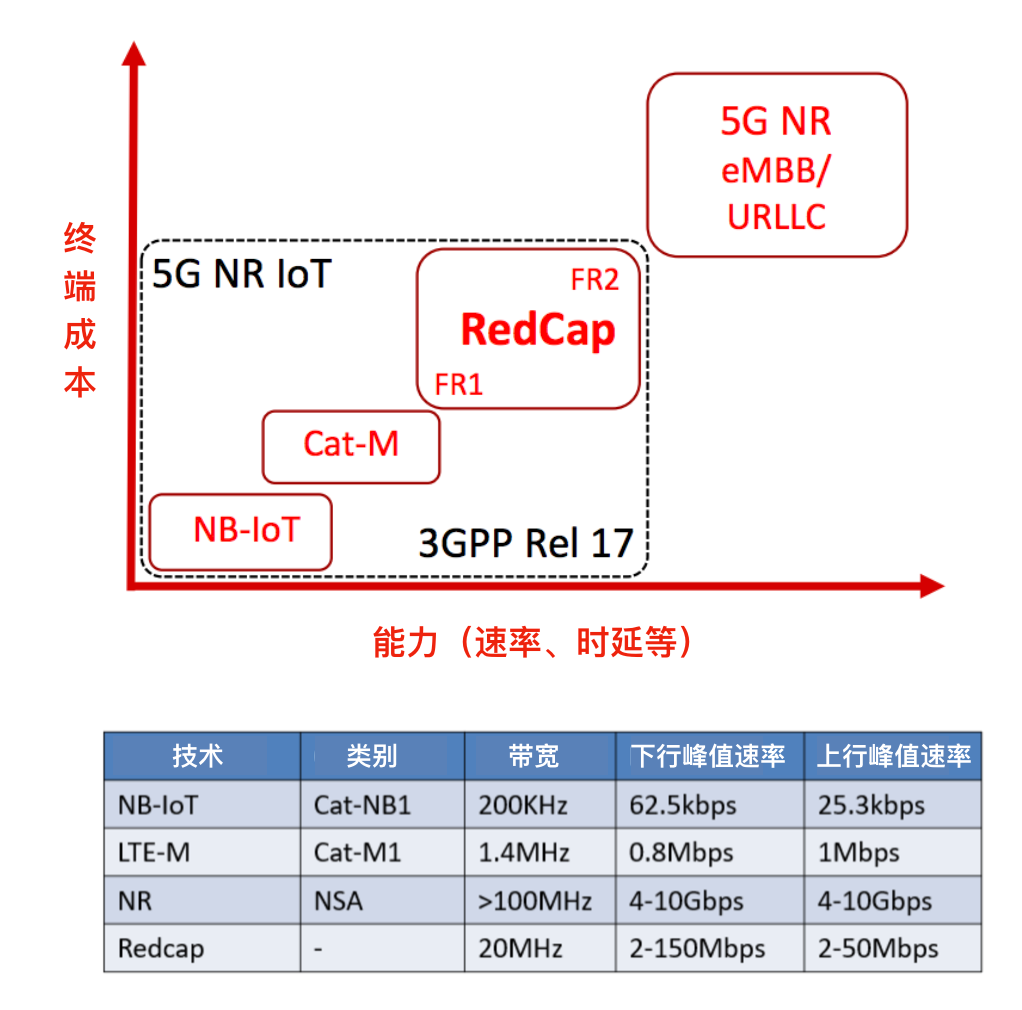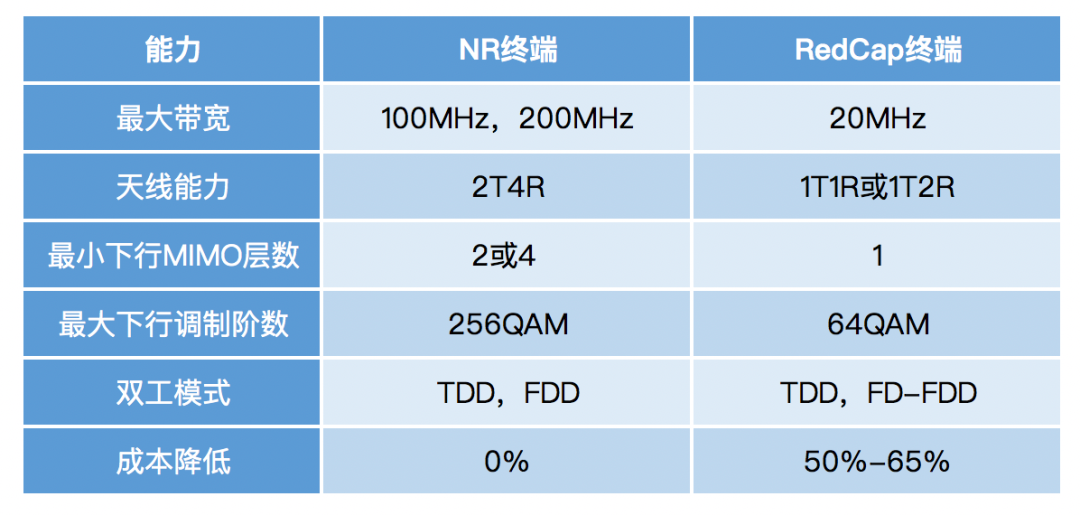What technology is RedCap in 5G R17?


A few days ago, 3GPP announced that the 5G R17 standard was frozen. In the R17 version, RedCap, the "Little Red Riding Hood", is particularly conspicuous, and is known as an indispensable piece of cake for the 5G Internet of Things.
So what exactly is RedCap? Let's talk about it below.
Why define RedCap?
Let's first take a look at the network capability requirements of wearable devices (including wearable watches, AR/VR glasses, etc.), industrial wireless sensors, and surveillance cameras:


As we all know, 5G eMBB supports a carrier bandwidth of more than 100MHz and a peak rate of up to 10Gbps; uRLLC supports millisecond-level delay and ultra-high reliability; and mMTC is evolved from NB-IoT and eMTC in the 4G era, and mainly supports bandwidths less than 1.4MHz, Low-speed, low-cost, low-power IoT connections with rates below 1Mbps.
However, it is not difficult to find from the above table that the network capability requirements of wearable devices, industrial wireless sensors, video surveillance and other use cases are between eMBB, uRLLC and mMTC capabilities.
Therefore, in order to match these use cases with requirements for speed, device cost and battery life between eMBB, uRLLC and mMTC, 3GPP defined support for RedCap NR devices in Release 17.

From the perspective of technology evolution, on the one hand, 4G has lower-cost LTE Cat-1, Cat-3, and Cat4 medium-rate IoT standards, but there is no smooth upgrade path for 5G NR; on the other hand, 5G has not yet For the medium-rate IoT standard corresponding to 4G, the existing modules supporting 5G eMBB are expensive. Therefore, in order to expand the IoT market in the 5G era, the industry urgently needs to define a more simplified and lower-cost 5G medium-rate IoT standard.
RedCap not only has simpler functions and lower cost, but more importantly, compared to 4G LTE medium-rate IoT solutions, it is native to 5G and naturally has the advantages of 5G NR, such as supporting a very wide range of frequency bands including millimeter waves, The network is more efficient, supports beamforming, can be connected to the 5G core network, etc., and can coexist with NR eMBB and uRLLC on NR carriers. Therefore, RedCap is expected to replace 4G medium-rate IoT and support a larger IoT market.
In the R17 version, RedCap mainly supports the following use cases:
- Industrial sensors: pressure sensors, humidity sensors, thermometers, motion sensors, accelerometers and actuators, etc.
- Surveillance Cameras: Applications in Smart Cities, Factories and Other Industrial Sites
- Wearable devices: smart watches, electronic health-related equipment, medical monitoring equipment, AR/VR glasses, etc.
In the R18 version, RedCap will further reduce terminal complexity, support a wider range of rates, and possibly add capabilities such as support for positioning, sidelink protocols, and unlicensed spectrum to support more use cases.
What abilities are cropped?
RedCap, the full name of Reduced Capability NR, literally means to reduce the NR capability. In the process of standard research, some manufacturers also called it NR-Light or NR-lite, and later 3GPP officially named it RedCap.
What capabilities does RedCap cut out?

As shown in the table above, in R17, RedCap mainly tailored the following functions, thereby reducing terminal complexity and cost by 50% to 65%.
- The maximum bandwidth is reduced from 100MHz of NR to 20MHz
- Minimum antenna configuration reduced from 2T4R for NR to 1T1R or 1T2R
- The minimum number of downlink MIMO layers is reduced to 1
- The maximum modulation order minimum can support 64QAM
- Introduced half-duplex mode
After maximizing function tailoring, RedCap can support a theoretical peak rate of up and down in the range of about 20Mbps-100Mbps in the FR1 frequency band, which is enough to meet the needs of most medium-speed IoT.
Of course, in order to achieve a higher peak rate, RedCap terminal equipment can also choose more advanced functions without cutting so hard, such as supporting 2 receiving antennas, 2 downlink MIMO layers, 256QAM, full-duplex FDD, etc.
Through tailoring, RedCap is close to LTE Cat-4 terminal capability in terms of data rate.
In addition to tailoring the physical layer functions listed above, RedCap also tailors some higher layer functions, such as reducing the maximum number of DRBs from 16 to 8, and reducing the PDCP SN and RLC-AM SN length from 18 bits. up to 12 bits, optional support for ANR function, etc.
What are the key technologies?
In addition to feature tailoring, it is important to mention that, in order to reduce the power consumption of end devices, RedCap introduced two energy-saving technologies in R17 that can extend battery life: eDRX and RRM measurement relaxation.
(1) eDRX
On the one hand, the data flow between the terminal and the network is usually intermittent or burst; on the other hand, if the terminal monitors the network paging all the time, it consumes a lot of power. Based on this, in order to make the terminal more power-saving, the DRX (discontinuous reception) mechanism was introduced for NR in the 5G R15 version, which allows the terminal to periodically monitor the PDCCH in the RRC_IDLE (idle state) and RRC_INACTIVE (inactive state) states. The channel is used to receive paging messages, and the remaining time is in a dormant state (the receiver is turned off), and there is no need to monitor paging, which can greatly reduce power consumption.
In NR, the maximum DRX cycle in RRC_IDLE and RRC_INACTIVE states is 2.56 seconds.
RedCap introduced the eDRX mechanism, which, as the name suggests, is an extended DRX mechanism, which extends the DRX cycle in the RRC_IDLE state to 10485.76 seconds (that is, about 3 hours), and extends the DRX cycle in the RRC_INACTIVE state to 10.24 seconds, so that the terminal sleep time Longer, more power saving, and longer battery life.
It is worth mentioning that when using the DRX mechanism, a trade-off between terminal power consumption and delay is required, that is, the longer the DRX cycle, the greater the downlink delay may be. Since RedCap is not as demanding as the eMBB/uRLLC use case in terms of latency and reliability, this makes it possible for RedCap to adopt the eDRX mechanism.
(2) RRM measurement relaxation
In the RRC-IDLE and RRC_INACTIVE states, the terminal will frequently perform RRM (Radio Resource Management) measurements to ensure that the terminal camps on the best available cell. RRM measurement mainly measures the RSRP and RSRQ values of the serving cell and neighboring cells. RRM measurements, while ensuring the best possible connection quality for the terminal, can drain battery power even when there is no data transfer between the terminal and the network.
In this regard, in version R16, the RRM measurement relaxation mechanism is defined for low-speed mobile and non-cell edge scenarios. When the low-speed condition is met for a certain period of time or when both low-speed and non-cell edge conditions are met, the device is allowed to relax the measurement of adjacent cells. For example, by increasing the RRM measurement period to reduce the number of adjacent cell measurements and the number of cell measurements, thereby reducing the power consumption of the terminal. In the R17 version, the relaxation time is further extended for RedCap terminals.
In addition, as mentioned above, since RedCap is native to 5G and naturally has the advantages of 5G NR, RedCap can also be combined with technologies such as 5G slicing, UPF sinking, uRLLC capability, coverage enhancement, 5G LAN, 5G positioning, terminal energy saving, etc. Match a variety of medium-rate IoT applications to better empower all walks of life.